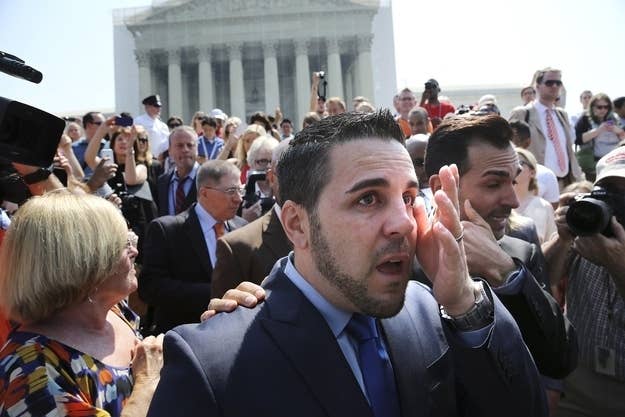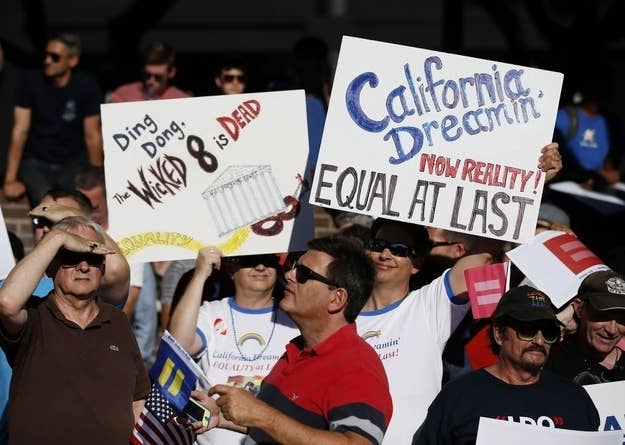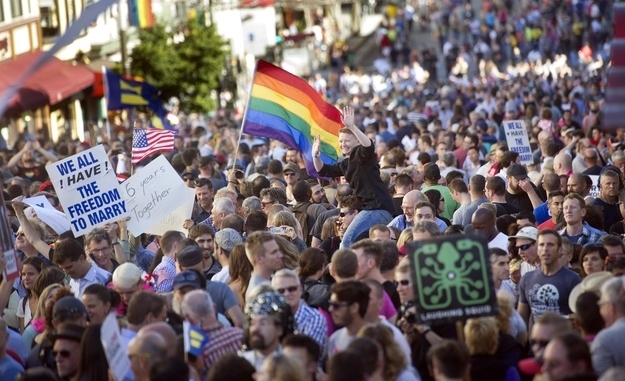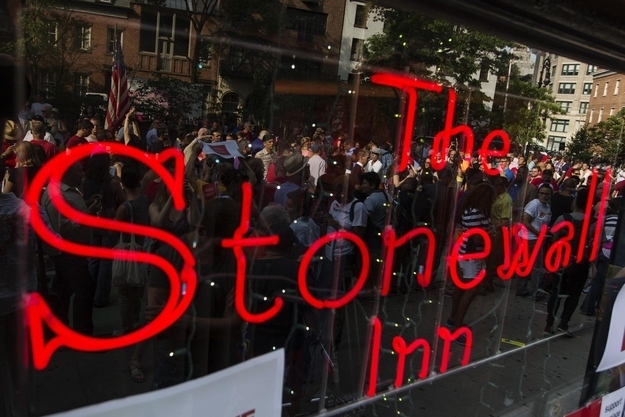
What The Court Decisions Do:
In the first case, Section 3 of the Defense of Marriage Act — the portion of the 1996 law that defined "marriage" and "spouse" as referring only to opposite-sex married couples — was struck down by the court as unconstitutional.
This means that the federal government is no longer banned from recognizing same-sex couples' marriages. This means that the more than 1,000 benefits and responsibilities of marriage contained throughout federal law should be open to gay and lesbian married couples. President Obama said that he has ordered Attorney General Eric Holder to work with cabinet officials "to review all relevant federal statutes to ensure this decision, including its implications for Federal benefits and obligations, is implemented swiftly and smoothly."
In one notable example, Homeland Security Secretary Janet Napolitano said Wednesday, "[W]e will implement today's decision so that all married couples will be treated equally and fairly in the administration of our immigration laws." This would include meaning that gay married couples in which one partner is a U.S. citizen and the other is not could obtain a green card for the non-citizen.
[Saturday Update: Gay Married Couple Receives Green Card Approval]
A variety of LGBT organizations — including Lambda Legal, Gay & Lesbian Advocates & Defenders, and the American Civil Liberties Union — issued a series of documents detailing their view of, as they put it, "After DOMA: What It Means For You."
In the other case, the court dismissed the appeal in the challenge to California's Proposition 8 marriage amendment, leaving in place the initial 2010 trial-court decision striking down the state amendment as unconstitutional.
This means that the two same-sex couples who sued California officials will be allowed to marry.
Additionally, the two couples, as part of their lawsuit, also asked the judge to issue a court order barring state officials — and the county clerks under their control — from enforcing Proposition 8 against anyone — in other words, ending Proposition 8. The trial-court judge included that order in his decision, and Chief Justice John Roberts noted in Wednesday's Supreme Court decision dismissing the appeal that the judge had done so.
Although some have suggested such a move was more broad than the trial-court judge was authorized to order, California Gov. Jerry Brown already announced that once the Supreme Court's decision is finalized and the trial-court judgment goes into effect, "the state's counties ... must begin issuing marriage licenses to same-sex couples." Unless that directive is halted by a future court order, marriage equality will return to California soon.
[Friday Update: Court Lifts Stay, Same-Sex Couples Marrying Again In California]

What The Court Decisions Do Not Do:
The court did not address whether states can ban same-sex couples from marrying. Including California, 13 states allow for marriage equality. Twenty-nine of the remaining states have constitutional amendments banning gay couples from marrying.
In Alaska, Arizona, Colorado, Mississippi, Missouri, Montana, Nevada, Oregon, and Tennessee, only marriages between one man and one woman are recognized. In Alabama, Arkansas, Florida, Georgia, Idaho, Kansas, Kentucky, Louisiana, Michigan, Nebraska, North Carolina, North Dakota, Ohio, Oklahoma, South Carolina, South Dakota, Texas, Utah, Virginia, and Wisconsin, same-sex couples are banned both from marriage and civil unions, with some states' provisions being even more restrictive.
By not addressing whether the "fundamental right to marry" that the court has discussed in the past applies to same-sex couples, those bans remain constitutional, at least for the time being.
Likewise, in the remaining states without either marriage equality or a constitutional ban on same-sex couples marrying, those couples are not now allowed to marry.
The court also did not address whether laws that target gay, lesbian and bisexual people — or transgender people — for discrimination should be subjected to heightened scrutiny by courts. This would impact not only marriage laws, but any other laws — now or in the future — that discriminate against LGBT people.
Finally, the court did not address Section 2 of DOMA, which tells states that they need not recognize same-sex marriages recognized by or entered into in other states.

What the Court Decisions Didn't Resolve and Remains Up in the Air:
The court issued a decision as to Edith Windsor's case in striking down Section 3 of DOMA, but it did not lay out the process of extending other benefits and responsibilities to same-sex married couples. The Obama administration, as the president has detailed, will have to figure all of that out.
Holder and Elaine Kaplan, the acting head of the Office of Personnel Management, will be two of the key people — along with Obama and senior White House staff — coordinating pieces of the federal response. Individual cabinet and agency heads will make specific changes, but expect the overall organization to come from the White House and these two people.
[Friday Update: Federal Government Begins Extending Employee Benefits To Same-Sex Spouses]
One of the key questions is how the federal government will address the relationships of same-sex couples who are married and live in a state with marriage equality and then move to a state that does not recognize their marriage. Although some federal laws count a couple as married if the marriage was valid in the "place of celebration" — in other words, if the marriage was valid in the state where the couple wed — other laws and policies determine the treatment based on whether the marriage is valid in the "place of residence."
Officials with some LGBT rights organizations already have said that they hope the government moves to an across-the-board policy of using the "place of celebration" method, which would lead to more same-sex couples receiving equal treatment by the federal government.
Another question is whether the federal government will treat couples with civil unions or domestic partnerships as married for federal law purposes. That issue was raised by Holder in an immigration case, and it likely will arise in other contexts in the coming months.
Finally, on that front, there are couples who live in states with no recognition for same-sex couples. A gay federal employee in a state like North Dakota who is in a long-term relationship will, in effect, begin receiving less in benefits than a gay federal employee in a state like Massachusetts who is married.
In the DOMA lawsuit, the court did not directly resolve a question raised in other pending cases about other laws — specifically, veterans' laws — that define marriage as limited to opposite-sex couples. As with Section 3 of DOMA, the House Republicans have led the defense of these laws in two ongoing lawsuits, one in California and one in Massachusetts. A question in coming weeks is whether the House Republicans will continue to mount the defense of those laws in the face of Wednesday's court ruling on DOMA.

